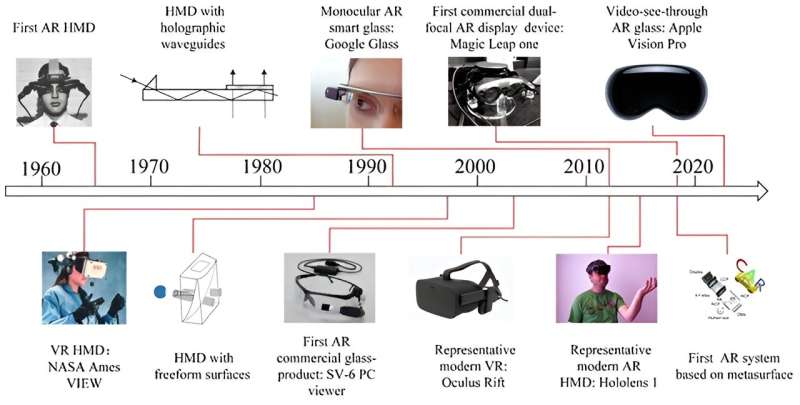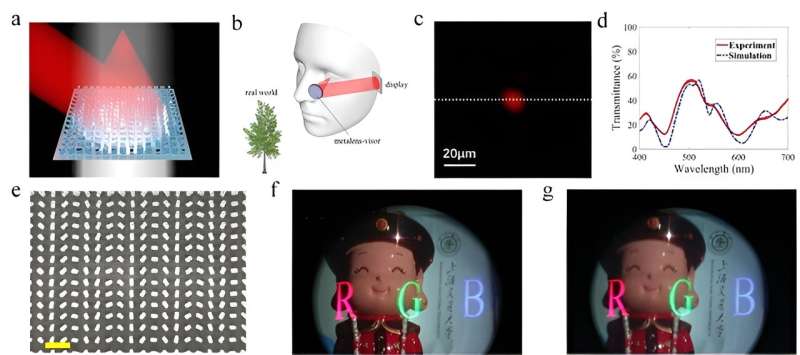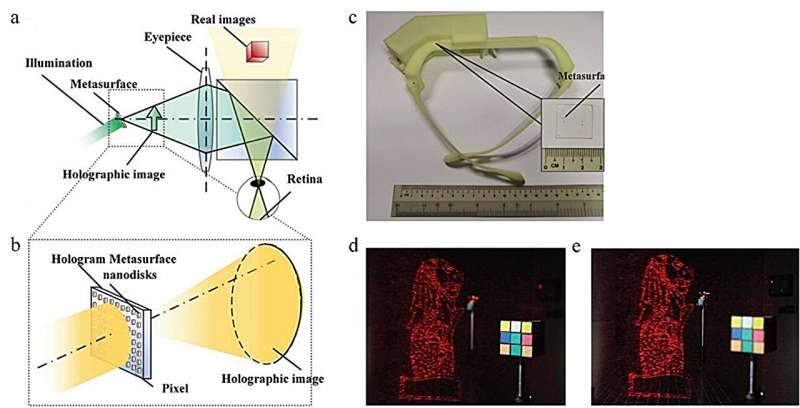This article has been reviewed according to Science X's editorial process and policies. Editors have highlighted the following attributes while ensuring the content's credibility:
fact-checked
proofread
Focus on AR/VR: Near-eye display based on metasurface devices

With the rise of the meta-universe, virtual reality (VR) and augmented reality (AR) technologies have been developing rapidly in recent years. Near-eye displays are crucial technologies for VR and AR. Despite the rapid advances in near-eye display technologies, there are still challenges such as large field of view (FOV), high resolution, high image quality, natural free 3D effect, and compact form factor.
Great efforts have been devoted to striking a balance between visual performance and device compactness. While traditional optics are nearing their limitations in addressing these challenges, ultra-thin metasurface optics, with their high light-modulating capabilities, may present a promising solution.
With the development of metasurface technology, novel metasurface devices have been applied for AR/VR near-eye display systems. To summarize the progress of metasurface for near-eye display applications in recent years, a team from Shanghai Jiao Tong University reviewed the latest progress of near-eye display based on metasurface devices. The work is published in the journal Opto-Electronic Science.
As shown in Figure 1, near-eye display technologies have witnessed rapid development over the past six decades since the introduction of the first AR HMD device in the 1960s. Familiar devices like Hololens and Apple Vision Pro are revolutionizing our lives. In 2018, metasurface devices were first proposed for near-eye displays. Metasurfaces, ultra-thin planar elements consisting of sub-wavelength antennas, offer superior modulation capabilities for light amplitude, phase, and polarization state, outperforming conventional refractive and diffractive optics.
Extensive research has been conducted on optical metasurface devices, including gratings, lenses, and holograms. Metasurfaces are promising candidates as key components in near-eye displays to replace bulky conventional optics or enable novel functionalities, paving the way for next-generation AR and VR technologies.
In this review, the authors first introduce VR and AR near-eye displays, and then briefly explain the working principles of light-modulating metasurfaces, review recent developments in metasurface devices geared toward near-eye display applications, delved into several advanced natural 3D near-eye display technologies based on metasurfaces.
The architecture of a VR display is relatively straightforward, composed of two main functional components: the image source and the eyepiece. In theory, metasurface devices could serve as either the image source or the eyepiece. However, for VR displays, the image source must provide large-size, video-rate, full-color images to create an immersive virtual environment. This requirement surpasses the capability of the state-of-art metasurfaces. Therefore, the application of metasurfaces in VR displays is primarily restricted to functioning as an eyepiece.
Given their versatile functionality, high optical performance and ultra-thin form factors, metasurfaces have been proposed as critical optical components in various AR display architectures. They can function as eyepieces, combiners, and more, substituting traditional bulky optics or integrating new advanced optical functionalities, to achieve more compact and lightweight, high image-quality and large FOV AR displays.

The authors reviewed the applications of metasurfaces in different AR architectures, based on beam splitters, waveguides and direct projection. As depicted in Figure 2, a multifunctional visor can simultaneously perform as an eyepiece for the oblique virtual image light and as a combiner that reflects the virtual image light into the viewer's eye while transmitting light from the real environment.
Metasurfaces hold great potential for applications in VR and AR near-eye displays to improve imaging performance, enlarge FOV or increase compactness. However, most near-eye displays still employ stereoscopic 3D display technology, which can lead to vergence-accommodation conflict (VAC) and visual fatigue. To address this issue, natural 3D display approaches have been proposed, including Maxwellian viewing display, holographic display, light field display, and multi-/vary-focal displays.

Thanks to the versatility of metasurfaces, metasurface devices have been employed as important optical elements in these advanced 3D near-eye displays to help alleviate visual fatigue and provide a more natural 3D visual experience. Figure 3 shows a Maxwellian-viewing near-eye display that can provide accommodation-free virtual images by using a Huygens' metasurface hologram as the display device.
This review provides an extensive overview of the recent advancements in the applications of metasurfaces for near-eye displays. Thanks to their ultra-thin form factors and exceptional flexibility in light modulation, metasurfaces offer a promising solution for the development of compact and lightweight VR/AR headsets.
More information: Yan Li et al, Metasurfaces for near-eye display applications, Opto-Electronic Science (2023). DOI: 10.29026/oes.2023.230025




















